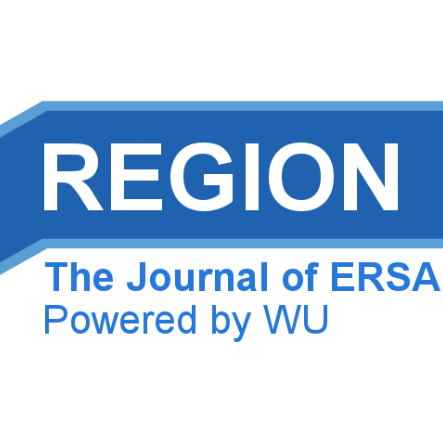Functional Labour Market Areas for Chile
DOI:
https://doi.org/10.18335/region.v4i3.199Keywords:
Spatial labour markets, Labour, EvolutionaryAbstract
Administrative areas are arbitrarily designed and do not necessarily reflect the geographical patterns of socio-economic and labour market activity. Labour market areas (LMAs) are required to analyse spatial labour market activity and provide a framework to guide spatially-explicit employment policy development. This resource describes a data source of a set of recently created labour market areas for Chile.References
Blanchard, O. & Katz, L. 1992. Regional evolutions. Brookings Papers on Economic Activity, 1 (1): 1–75.
Boschma, R.A. & Frenken, K., 2006. Why is economic geography not an evolutionary science? Towards an evolutionary economic geography. Journal of economic geography, 6(3): pp.273-302.
Casado-Díaz JM, Martínez-Bernabéu L, and Rowe F (2017) An evolutionary approach to the delimitation of labour market areas: an empirical application for Chile. Spatial Economic Analysis, 1–25.
Hidalgo, C.A. & Hausmann, R., 2009. The building blocks of economic complexity. Proceedings of the National Academy of Sciences, 106(26): pp.10570-10575.
Martínez-Bernabeu, L.; Flórez-Revuelta, F. & Casado-Díaz, J.M. (2012) Grouping genetic operators for the delineation of functional areas based on spatial interaction. Expert Systems with Applications, 39 (8) pp. 6754-6766.
Rowe F, (2013) Spatial labour mobility in a transition economy: Migration and commuting in Chile PhD Thesis, School of Geography, Planning and Environmental Management, The University of Queensland.
Rowe F, (2014) Micro and macro drivers of long-distance commuting in Chile: The role of spatial distribution of economic activities and population. 53rd Western Regional Science Association. San Diego, United States, 1–35.
Rowe F, & Bell, M, (forthcoming) The drivers of long-distance commuting in Chile: The role of spatial distribution of economic activities and population. In J. Poot & M. Roskruge (Eds.), Regional science perspectives on population change and impacts in Asia and the Pacific. Springer.
Published
How to Cite
Issue
Section
License
REGION is an open journal, and uses the standard Creative Commons license: Copyright We want authors to retain the maximum control over their work consistent with the first goal. For this reason, authors who publish in REGION will release their articles under the Creative Commons Attribution license. This license allows anyone to copy and distribute the article provided that appropriate attribution is given to REGION and the authors. For details of the rights authors grant users of their work, see the "human-readable summary" of the license, with a link to the full license. (Note that "you" refers to a user, not an author, in the summary.) Upon submission, the authors agree that the following three items are true: 1) The manuscript named above: a) represents valid work and neither it nor any other that I have written with substantially similar content has been published before in any form except as a preprint, b) is not concurrently submitted to another publication, and c) does not infringe anyone’s copyright. The Author(s) holds ERSA, WU, REGION, and the Editors of REGION harmless against all copyright claims. d) I have, or a coauthor has, had sufficient access to the data to verify the manuscript’s scientific integrity. 2) If asked, I will provide or fully cooperate in providing the data on which the manuscript is based so the editors or their assignees can examine it (where possible) 3) For papers with more than one author, I as the submitter have the permission of the coauthors to submit this work, and all authors agree that the corresponding author will be the main correspondent with the editorial office, and review the edited manuscript and proof. If there is only one author, I will be the corresponding author and agree to handle these responsibilities.




